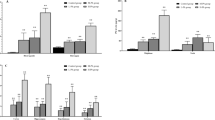Abstract
The purpose of this study was to evaluate species differences in tissue accumulation of chromium. Rats and mice were orally exposed to Cr(VI) (potassium chromate) via drinking water (8 mg/d/kg body wt for 4 or 8 wk) or by ip injection (0.3 and 0.8 mg/d/kg, for 4 or 14 d). Chromium concentrations were measured by atomic absorption spectrophotometry, and tissues were compared for exposure route and species differences. After oral exposure, irrespective of treatment duration, liver concentrations of chromium were three to four times higher in mice than rats, whereas kidney concentrations were about 50% lower. However, after ip injection, kidney and blood concentrations in rats were two- and four-fold, higher, respectively. Both rats and mice showed high values of Cr concentration in the bone. After single ip injection of Na2 51CrO4; Cr concentrations were higher in the blood of rats than mice both after 24 and 72 h. Red blood cell concentrations of Cr were also greater in rats than mice by approximately threefold, whereas white blood cell Cr concentrations were higher in mice than rats. There was also a twofold greater binding of Cr/μmol of hemoglobin in rats compared to mice. These data indicate that species differences exist for Cr metabolism and that they differ with respect to the route of exposure. These results may be owing to species differences in the reduction of Cr and different binding of Cr to hemoglobin.
Similar content being viewed by others
References
A. Leonard and R. R. Lauwerys,Mutat. Res. 76, 227–239 (1980).
M. Cohen, D. M. Latta, T. P. Coogan and M. Costa,Biological Effects of Heavy Metals, vol. 2, Mechanism of Metal Carcinogenesis, F. Foulkes, ed., CRC Press, Boca Raton, FL, 1990, pp. 19–75.
S. Kitagawa, H. Seki, F. Kametami, and H. Skurai,Chem.-Biol. Interact. 40, 265–274 (1982).
A. Kortenkamp, D. Beyersmann, and P. O'Brien,Toxicol. Environ. Chem. 14, 23–32 (1987).
J. Aiyar, K. M. Borges, R. A. Floyd, and K. E. Wetterhahn,Toxicol. Environ. Chem. 22, 135–148 (1989).
P. H. Connett and K. E. Wetterhahn,Struct. Bond. 54, 93–124 (1983).
P. Arslan, M. Beltrame, and A. Tomasi,Biochim. Biophys. Acta 931, 10–15 (1987).
G. J. Hughes, C. De Jong, R. W. Fischer, K. H. Winterhalter, and K. J. Wilson,Biochem. J. 199, 61–67 (1981).
H. U. Wolf, W. Land, and R. Zander,Clin. Chim. Acta 136, 95–104 (1984).
C. J. P. Eriksson, H. W. Sippel, and O. A. Forsander,FEBS Lett. 75, 205–208 (1977).
N. S. Kosower, E. M. Kosower, and R. L. Koppel,Eur. J. Biochem. 77, 529–534 (1977).
S. J. Gray and K. Sterling,J. Clin. Invest. 29, 1604–1613 (1950).
B. Buttner and D. Beyersmann,Xenobiotica 15, 735–741 (1985).
H. J. Wiegand, H. Ottenwalder, and H. M. Bolt,Arch. Toxicol. 57, 31–34 (1985).
T. P. Coogan, K. S. Squibb, J. Motz, P. L. Kinney, and M. Costa,Toxicol. Appl. Pharmacol. 108, 157–166 (1991).
R. D. MacKenzie, R. A. Anwar, R. U. Beyerrum, and C. A. Hoppert,Arch. Biochem. Biophys. 79, 200–205 (1959).
A. Mutti, A. Cavatorta, L. Borghi, M. Canali, C. Giaroli, and I. Franchini,Med. Lavoro 3, 171–179 (1979).
S. Yamaguchi, K. Sano, and N. Shimojo,Ind. Health 21, 25–34 (1983).
Y. Sayato, K. Nakamuto, S. Matsui, and M. Ando,J. Pharm. Dyn. 3, 17–23 (1980).
Y. Suzuki and K. Fukuda,Arch Toxicol. 64, 169–176 (1990).
H. Weber,J. Toxicol. Environ. Health 11, 749–764 (1983).
K. S. Squibb, S. Cosentino, M. Costa, and C. A. Snyder,The Toxicologist 11, 40 (1991).
R. M. Donaldson and R. F. Barreras,J. Lab. Clin. Med. 68, 484–493 (1966).
S. C. Rossi, N. Gorman, and K. E. Wetterhahn,Chem. Res. Toxicol. 1, 101 (1988).
C. Veillon and Patterson, K. Y., Environmental Carcinogens—Selected Methods of Analysis, Vol. 8, Some Metals: As, Be, Cd, Ni, Pb, Se, Zn. (I. K. O'Neil, P. Schuller and L. Fishbein, Eds.) IARC Scientific Publication No. 71, pp. 433–440. Oxford Univ. Press, New York (1986).
Author information
Authors and Affiliations
Rights and permissions
About this article
Cite this article
Kargacin, B., Squibb, K.S., Cosentino, S. et al. Comparison of the uptake and distribution of chromate in rats and mice. Biol Trace Elem Res 36, 307–318 (1993). https://doi.org/10.1007/BF02783964
Received:
Accepted:
Issue Date:
DOI: https://doi.org/10.1007/BF02783964




